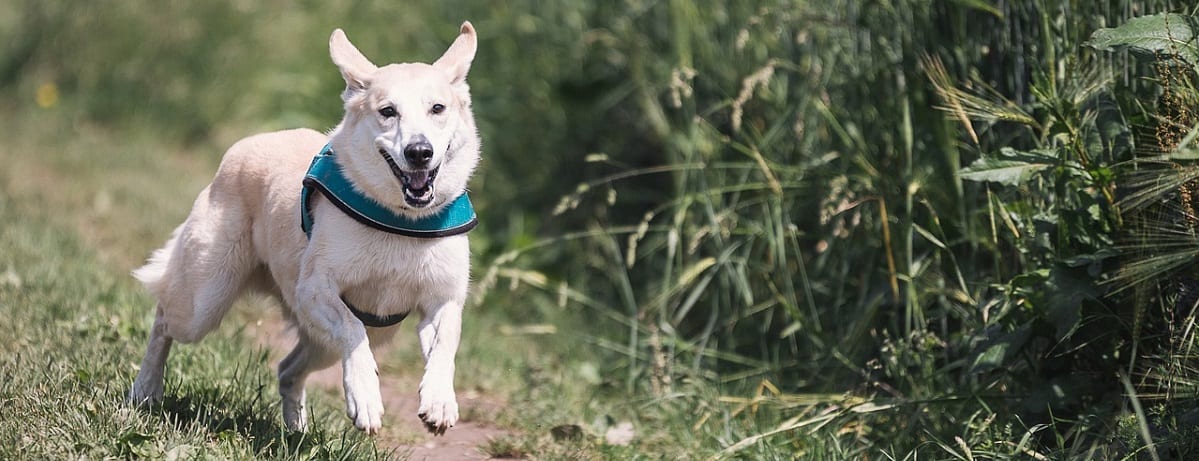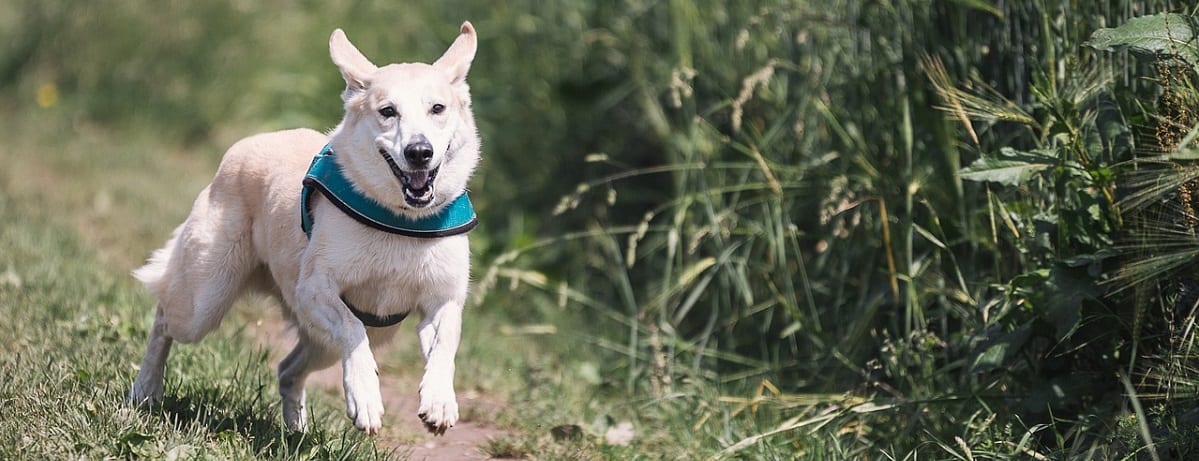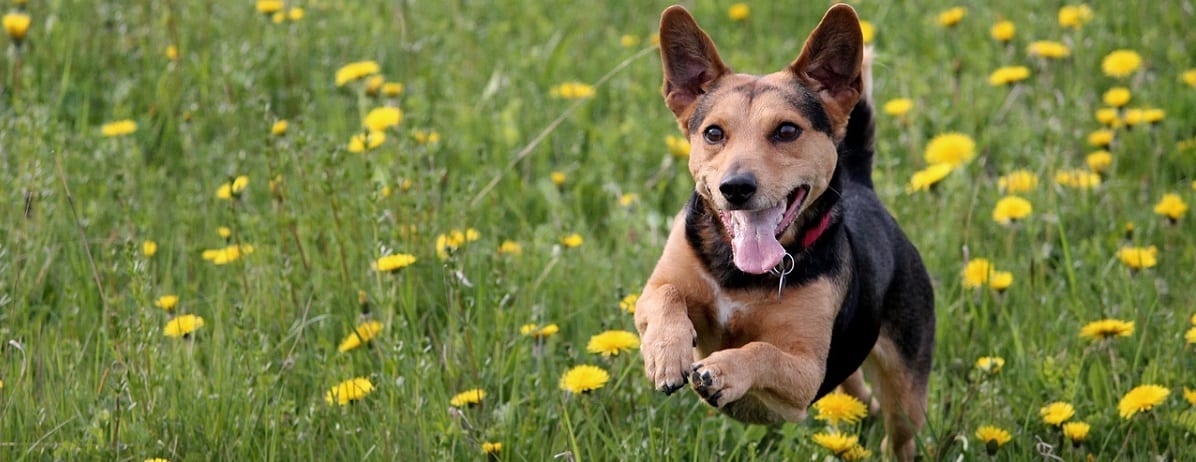Have you ever witnessed a dog struggling to stand up, using only its front paws to ease the discomfort on its back legs? This is a classic case of hip dysplasia, and it’s only one of many joint issues dogs can experience. Joint pain, osteoarthritis, dysplasia, and osteochondrosis dissecans are all serious joint health issues that need to be dealt with as soon as their symptoms arise. Otherwise, the pain can become unbearable, and dogs will lose their inhibition to play, go on walks, or even greet you at the door—an act so sacred in our hearts we can’t imagine a day without it.
To learn about the importance of dog joint health and to actively prevent their degradation, read ahead.
Joint Breakdown: What Constitutes a Joint?
There are a few basic components of a joint, each with their own function to play.
- Connecting bones – The bones make up the structure of the joint. How they’re shaped when the dog is developing determines the joint’s integrity and stability.
- Cartilage – Dampening the pounding effect when standing up, running, and jumping, is the cartilage. Cartilage is a firm connective tissue between the bones. When the cartilage is damaged or worn away, the bones have nothing to prevent their colliding—this causes significant pain and inflammation.
- Synovium and synovial fluid – There is lubrication between the bones and the cartilage that allows for bones to glide across each other freely. Without the synovial fluid, the cartilage is susceptible to wear and tear. Once the cartilage is damaged, arthritis is likely to come next.
- Ligaments – Finally, the connective fibers along the sides of the joint are called the ligaments. These attach from bone to bone and prevent them from moving out of place.
Why Joints are Important
Joints are what allow dogs (and us) to move freely about the world. Without the joints themselves, our skeletons would have no firm structure (or oppositely, we’d be a stiff upright bag of bones). Without the padding between these bones, any time we jumped, jogged, or simply changed positions, our bones would knock into each other and damage our skeletal structure.

Joint pain, arthritis, and bone degradation are common complaints for elderly dogs because as they age, the synovium produces less lubrication. Once the cartilage is damaged, repairing the joint can be difficult. For this reason, the importance of dog joint health cannot be understated.
Developmental or Degenerative: Joint Disease Categories
Joint disease typically falls under one of two categories: developmental or degenerative. Developmental joint issues come from either the overdevelopment or underdevelopment of the bones connected at the joints. Hip sockets, for example, are often too big and cause the hip bone to pop out and in, rubbing the two bones together. This constant friction is what causes hip dysplasia as the dog ages.
The other type of joint problem is degenerative joint disease. DJD, or osteoarthritis, is the most common cause of arthritis in dogs, and it occurs when the cartilage deteriorates around the bones. Older dogs are prone to develop DJD, especially if their synovium stops producing lubricating fluid.
Signs and Symptoms of Joint Problems
Because of the constant pain associated with DJD and arthritis, dogs have a hard time hiding it. Even a halfway attentive owner will notice one of the many signs and symptoms of joint problems:
- Limping or favoring one side – The most noticeable sign your dog is developing arthritis is when they limp or favor one side over the other. They do this to keep the weight off their affected joint.
- Standing with only front legs – Hip dysplasia, the most common form of arthritis, can be spotted when your dog stands up—they’ll only use their front legs. This is to avoid putting pressure on the hind legs and hips.
- Refusal to jump or climb stairs – Jumping and inclining are stressful activities on joints. If your dog suddenly looks at a San Francisco-esque hill, and then gives you that “you’ve got to be kidding me” look, you’ll know it’s time to visit the vet.
- Swollen joints – The inflammation caused by joint pain will typically cause the joints to swell. Noticing this early can be one way to prevent further damage to the joint.
- Muscle degeneration – Dogs are sometimes able to hide their joint pain by displacing their weight to their other legs. This quickly degenerates the muscles around the affected joint, worsening the problem.
- Licking the affected joint – When dogs experience a cut, they’ll lick the wound to help it heal. Knowing that there’s something wrong in their body, they will sometimes lick the affected joint in an attempt to relieve some of the pain.
- Changes in temperament – Being greeted by our tail-wagging friends after a long day is always a treat. But when our furry companion develops chronic pain in the hips, knees, or elbows, this habitual greeting can suddenly become a thing of the past. Unfortunately, this inability to move can cause a complete change in temperament and can even cause irritability.
- Depression or lethargic behavior – Part of being a dog is the excitement of running around, smelling new smells, and playing with the greatest toy humans have ever invented—the ball! When all of this is hampered by the pain in their joints, their mood can sometimes spiral into depression.
Diagnosing and Treating Joint Pains
If your dog is acting strange, and you believe it is caused by their joints, it’s imperative that you visit your local veterinarian immediately. Certain joint disorders can be resolved, allowing your dog to live a relatively pain-free life. However, this often depends on how early the joint disease is caught.

Process of Diagnosing
The veterinarian has a number of strategies to identify joint problems and their underlying causes.
- Physical examination – By stretching and flexing different muscle groups, vets can identify which joint is affected and to what degree.
- Biopsy of the joint – By sampling a piece of the joint interior, vets can determine if an infectious disease is the cause of the joint problem. If it is, antibiotics can be used to remove the infection, and your dog could experience a full recovery.
- Bloodwork – Identifying whether the joint deterioration is due to something like an autoimmune disease is important. Autoimmune diseases are when your immune system attacks healthy cells. If they identify the cartilage or synovial fluid as pathogens, then a combination of steroids and immunosuppressants might be necessary.
Medical Intervention vs Surgical Intervention
Whenever possible, medical intervention is always better than surgical. All surgeries come with a risk of fatality, and they’re not guaranteed to do more than alleviate the symptoms. Medical intervention, however, attempts to offer the dog a normal life. This usually involves some combination of anti-inflammatories, pain relievers, and certain medications used to promote joint repair.
Surgical intervention, on the other hand, is often needed in the most extreme cases of arthritis—when the afflicted dog can no longer walk. In this case, the surgeon attempts to flush out the affected joint and rebuild or reshape any joint deformities. As mentioned, surgery typically does not fix the underlying cause. However, it’s effectiveness will sometimes allow a dog to respond to medical intervention.
Improving Joint Health for Dogs
There are a few different techniques to improve joint health for dogs. Some involve relieving the stress that accumulates on the joints. Other methods target the muscle groups around the joint to improve flexibility and to provide load-bearing assistance. A combination of the two is your best bet for improving your dog’s joints.
When targeting the stress and pressure on the actual joints, you can:
- Help your dog keep a lean figure – Obesity and being overweight is potentially the biggest stressor on joints. The extra weight is not subsidized by extra cartilage or synovial fluid, which means the bones are being squeezed closer together, increasing the friction. Feeding your pup a healthy diet and getting getting your dog’s body to their proper weight will alleviate some of the pressure on their joints.
- Improve their diet – Having a healthy diet creates a healthy gut biome. A healthy gut biome improves everything from mood to heart health to joint health. Combining healthy ingredients and a dietary supplement is a great way to improve your dog’s quality of life and keep their joints strong.
- Low impact exercises – Unfortunately, if your dog is diagnosed with arthritis, it might mean that fetch is off the table. High impact activities like running, jumping, and catching could destabilize their joints and seriously injure your dog. Instead, low impact exercises are a great way to keep your dog stimulated and safe.
-
- Walking – Who doesn’t love a good walk? It’s low-impact, great for the mind (yours and your dogs), and it’s a great way to relax at the end of a long day. Building a walk into your daily routine is a great way to keep your dog in a cheery mood.
-
- Swimming – Swimming around lakes, rivers, and oceans is a fun, low-impact exercise that’s perfect for dogs with joint problems.
-
- Indoor games – Because most outdoor games involve high-impact running, try switching to indoor games. Teach your dog to find toys using their excellent sense of smell. A little game of hide and seek will be a welcomed surprise for your dog.
-
- Trick training – Dogs crave mental stimulation. Learning new tricks and new words expands their vocabulary and creates a stronger bond with you as their owner. Research shows that some dogs can learn up to 250 words, each corresponding to different commands.
-
- Hiking – Yes, yes, this is just an iteration of walking. But walking typically means routine smells and the same spots. While dogs do love this, a switch up now and again to a new world (a hiking trail) will do wonders for your dog’s mental health.
- Ramps instead of stairs – If your daily walk typically involves climbing a lot of stairs, using ramps could be a way to support your dog’s joints. Especially if your dog likes to jump off the last few steps, this will prevent them from further degrading their weak joints.
When targeting the muscle groups around the joint, you can:
- Help your dog stretch – When your dog is calm and lying down, you can coax them into a few stretching exercises. Have your veterinarian show you what stretches are beneficial for the affected joints. And make sure you have treats ready. This way, your dog will enjoy stretching time and be more willing to let you do it.
- Strengthening exercises – While you can’t exercise the joint specifically, you can toughen up the muscles around the joint. This will allow some of the stress to be alleviated from the joint itself.
|
Living With a Joint Disease
Joints are tricky pieces of the dog anatomy. Because there’s not much to them—bones attached with some padding and lubrication between them—there’s not much to fix when something goes wrong. The best option for joint health is to reinforce them in the preventative stage rather than the rebuilding stage. To this end, treating your dog to a healthy lifestyle can prevent chronic pain later in their life.
However, if your dog is experiencing some form of arthritis or degenerative joint disease, know that there are options available. Medical and surgical intervention can be combined with holistic care to give your dog the best chance to live a happy, healthy life.
Sources:
Pets Web MD. Dog Joint Health: Pain, Osteoarthritis, and Other Joint Problems. https://pets.webmd.com/dogs/guide/dog-joint-health-pain-osteoarthritis-and-other-joint-problems#1
Petful. How Many Words Can a Dog Understand? https://www.petful.com/behaviors/how-many-words-can-dog-understand/
PetMD. How to Treat Arthritis and Joint Pain in Dogs. https://m.petmd.com/dog/general-health/evr_dg_remedies_for_arthritis_in_dogs
PetMD. Green Lipped Mussels for Dogs: How They Can Help. https://www.petmd.com/dog/wellness/green-lipped-mussels-dogs-how-they-can-help
 Dr. Melinda J. Mayfield-Davis, DVM, WCHP-AH, brings over 20 years of experience in veterinary medicine. She is the Technical Services Veterinarian with Innovacyn, Inc., parent company of Vetericyn Animal Wellness. She received her DVM from Oklahoma State University and now resides in Southeast Kansas with her husband, two children, four dogs, and six horses. Prior to working with Innovacyn, Dr. Mayfield owned and operated the Animal Care Center in Columbus, KS.
Dr. Melinda J. Mayfield-Davis, DVM, WCHP-AH, brings over 20 years of experience in veterinary medicine. She is the Technical Services Veterinarian with Innovacyn, Inc., parent company of Vetericyn Animal Wellness. She received her DVM from Oklahoma State University and now resides in Southeast Kansas with her husband, two children, four dogs, and six horses. Prior to working with Innovacyn, Dr. Mayfield owned and operated the Animal Care Center in Columbus, KS.



